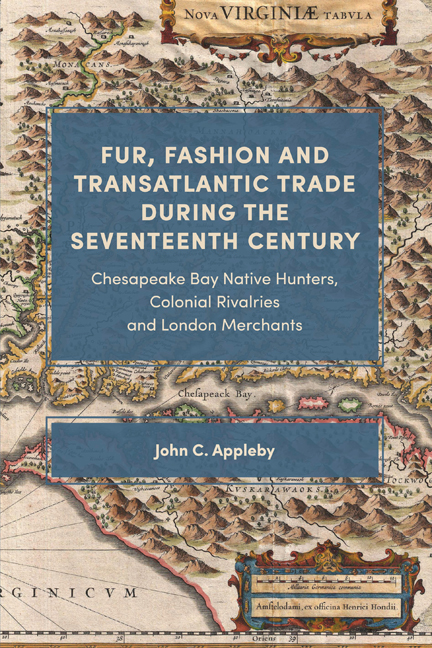 Fur, Fashion and Transatlantic Trade during the Seventeenth Century
Fur, Fashion and Transatlantic Trade during the Seventeenth Century Book contents
- Frontmatter
- Contents
- Acknowledgements
- A Note on Conventions
- Abbreviations
- Maps
- Introduction
- 1 Fur and Fashion: The Infrastructure of a New Trade
- 2 Commerce and Colonization: The Emergence of the Fur Trade in Chesapeake Bay
- 3 Trade and Rivalry: The Promise of Expansion and Innovation during the 1630s
- 4 Trade, Rivalry and Conflict during a ‘Time of Troubles’ from 1640 to 1660
- 5 Commercial Change and Conflict: Contrasting Experiences after 1650
- 6 Trade, Consumption and Industry: Transatlantic Constraints on the Bay Trade
- Conclusion
- Appendix
- Select Bibliography of Works Consulted
- Index
2 - Commerce and Colonization: The Emergence of the Fur Trade in Chesapeake Bay
Published online by Cambridge University Press: 15 December 2020
- Frontmatter
- Contents
- Acknowledgements
- A Note on Conventions
- Abbreviations
- Maps
- Introduction
- 1 Fur and Fashion: The Infrastructure of a New Trade
- 2 Commerce and Colonization: The Emergence of the Fur Trade in Chesapeake Bay
- 3 Trade and Rivalry: The Promise of Expansion and Innovation during the 1630s
- 4 Trade, Rivalry and Conflict during a ‘Time of Troubles’ from 1640 to 1660
- 5 Commercial Change and Conflict: Contrasting Experiences after 1650
- 6 Trade, Consumption and Industry: Transatlantic Constraints on the Bay Trade
- Conclusion
- Appendix
- Select Bibliography of Works Consulted
- Index
Summary
Richard Hakluyt the younger was one of the first English commentators to draw attention to the value of the fur trade in North America for commercial and colonial expansion. A clergyman, Hakluyt devoted his career to collecting and publishing accounts of English voyages in an attempt to promote colonization with the support of the monarchy. In 1583 he was sent to Paris by Sir Francis Walsingham, Queen Elizabeth's Secretary, to acquire information on French activity in the New World while serving as chaplain in the residency of the ambassador. During a mission of nine months Hakluyt met merchants and seafarers, providing Walsingham with up-to-date reports on French enterprise. Shortly after his return to London he completed ‘The Discourse of Western Planting’, a confidential document for the queen and a small group of prominent supporters of American colonization, in which he noted the great quantity of furs available in the gulf of the St Lawrence River. Embroidering eye-witness reportage, Hakluyt portrayed North America as a vast cornucopia, rich with precious metals and stones, spices and drugs, dyes, all kinds of fruits, timber and fish, as well as a multitude of animals that could provide tallow and hides. Here was a land that could compensate England for declining trades in Europe, so long as adventurers were prepared to face hostility from the French and others.
Despite Hakluyt's clarion call for action, English ambitions and enterprise faltered, while French adventurers, responding to the demand for fur in Paris, established an extensive trading network along the St Lawrence. Nonetheless, during a pioneering phase of episodic English overseas expansion, fishermen, traders and settlers developed widespread interests in the trade in beaver skins. At various locations along the eastern seaboard of North America they established small, impermanent and shifting commercial sites, in competition with French and Dutch adventurers. It was an intermittent enterprise, conducted in fleeting, sometimes suspicious, cross-cultural exchanges, which drew various Indian groups, eager to acquire trade goods, into contact with Europeans in search of furs. Although the commercial zones that emerged during the late sixteenth and early seventeenth centuries were little more than pinpricks in a vast and unknown continent, they created beachheads for the growth of trade and, in some cases, settlement.
- Type
- Chapter
- Information
- Fur, Fashion and Transatlantic Trade during the Seventeenth CenturyChesapeake Bay Native Hunters, Colonial Rivalries and London Merchants, pp. 45 - 84Publisher: Boydell & BrewerPrint publication year: 2021


